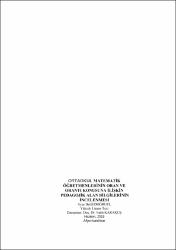Ortaokul matematik öğretmenlerinin oran ve orantı konusuna ilişkin pedagojik alan bilgilerinin incelenmesi
Abstract
Bu çalışmanın amacı, ortaokul matematik öğretmenlerinin oran ve orantı konusuna ilişkin pedagojik alan bilgilerini (PAB) Ball, Thames ve Phelps (2008) tarafından geliştirilen, “Öğretim İçin Matematik Bilgisi’’ (ÖMB) modeli kuramsal çerçevesinden yararlanarak incelemektir.
Çalışmada nitel araştırmalardan karma araştırma yöntemi kullanılmıştır. Çalışma 2017-2018 Eğitim-Öğretim yılında Afyonkarahisar il merkezinde çalışan ve maksimum çeşitlilik örneklemesine göre seçilen 90 gönüllü ortaokul matematik öğretmeniyle gerçekleştirilmiştir.
Çalışmada ÖMB modeli temel alınarak 14 sorudan oluşturulan anket öncelikle 90 öğretmene uygulanmış, ardından bu öğretmenler içinden gönüllü olan ve her bir kıdem düzeyinden en az birer tane olmak üzere belirlenen 13 öğretmen ile yarı yapılandırılmış görüşmeler gerçekleştirilmiştir. Sonra bu 13 öğretmen içinden amaçlı örnekleme ile seçilmiş 6 öğretmenin oran ve orantı konusunu işledikleri dörder saatlik dersleri gözlemlenmiştir. Ders süreci gözlemlerinin ardından öğretmenlerle yapılandırılmamış görüşmeler yapılmıştır. Tüm gözlem ve görüşmeler video ve ses kayıtları ile kayıt altına alınmış ve bu kayıtlar bilgisayar ortamında birebir yazıya aktarılmıştır. Elde edilen verilerin analizinde, içerik analizi yöntemi kullanılmıştır.
Çalışmanın bulgularına göre; öğretmenlerin oran ve orantı konusuna ilişkin PAB’larının ÖMB bileşenleri olan özel alan bilgisi (ÖAB) ile öğretim ve alan bilgisi (ÖtAB) bileşenleri bağlamında yeterli düzeyde olmadığı tespit edilmiştir. Genel alan bilgileri (GAB) ile öğrenci ve alan bilgilerinin (ÖğAB) yeterli düzeyde olmasına rağmen oran tanımında sıkıntılar olduğu, çok büyük bir kısmının ise oran tanımını bilmedikleri ve yanlış cevap veren öğrenciye kural temelli ve teorik açıklamalarla anlatmayı tercih ettikleri belirlenmiştir. Ayrıca öğretmenlerin mesleki kıdem düzeyi arttıkça GAB, ÖğAB ve ÖtAB’lerinin azaldığı fakat ÖAB’lerinin arttığı tespit edilmiştir. The purpose of this study is to analyze pedagogical content knowledge (PCK) of secondary school mathematics teachers on the subject of ratio and proportion through taking advantage of the theoretical framework of ‘’Mathematical Knowledge for Teaching’’ (MKT) model developed by Ball, Thames and Phelps (2008).
Mixed research method was used in the study. The study was executed with 90 volunteer middle school mathematics teachers working in the city center of Afyonkarahisar in 2017-2018 academic year and selected according to the maximum diversity sampling.
In the study, a questionnaire consisting of 14 questions based on MKT model was applied to 90 teachers, then semi-structured interviews were conducted with 13 teachers, with at least one of each seniority level, who were volunteers from these teachers and determined by purposeful sampling. Then, the four-hour courses were observed in which 6 teachers, selected from these 13 teachers with purposive sampling, taught the subject of ratio and proportion. After the course process observations, unstructured interviews were conducted with the teachers. All observations and interviews were recorded with video and audio recordings and these recordings were written on computer. Content analysis methods was used in the analysis of the obtained data.
According to the findings of the study; teachers' pedagogical content knowledge (PCK) on the subject of ratio and proportion has been identified as insufficient in the context of Specialized Content Knowledge (SCK) and Knowledge of Content and Teaching (KCT) which are the components of Mathematical Knowledge for Teaching (MKT). Although their Common Content Knowledge (CCK) and Knowledge of Content and Students (KCS) is sufficient, it was detected that they have some troubles on the definition of ratio. Moreover, most of them do not know the definition of ratio, and prefers to tell the students who answered incorrectly by rule based and theoretical explanations. In addition, it was found that as teachers' professional seniority level increases, their CCK, KCS and KCT decreases, however their SCK increases.
Collections
- Yüksek Lisans Tezleri [1638]



















